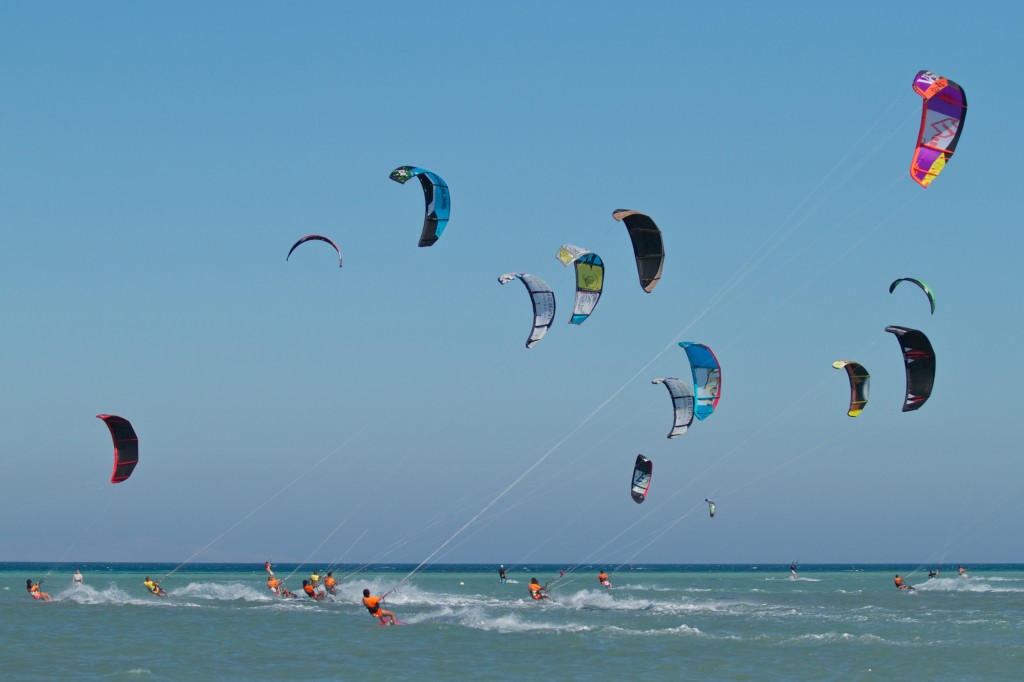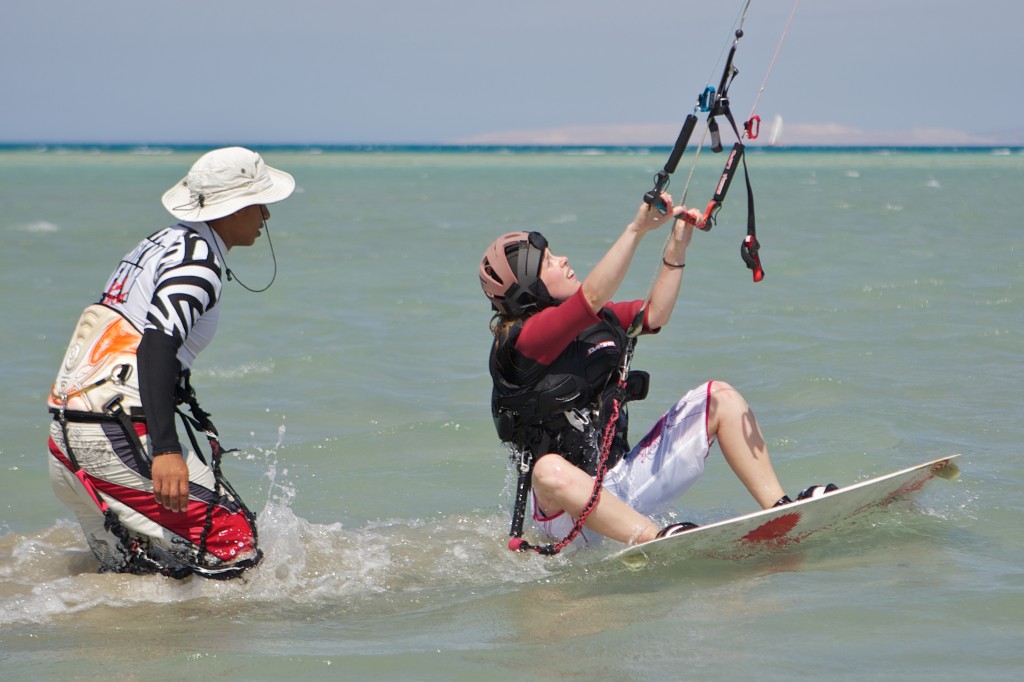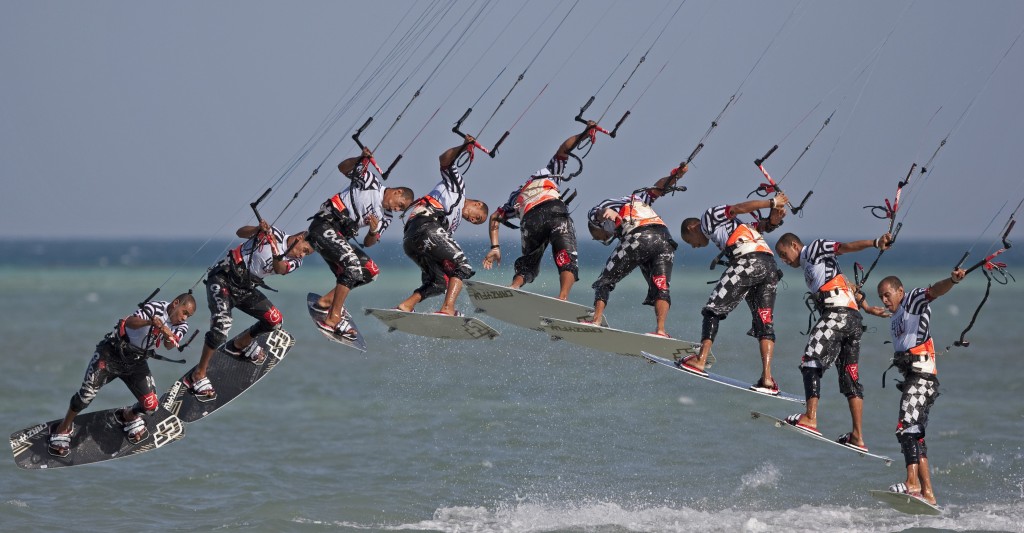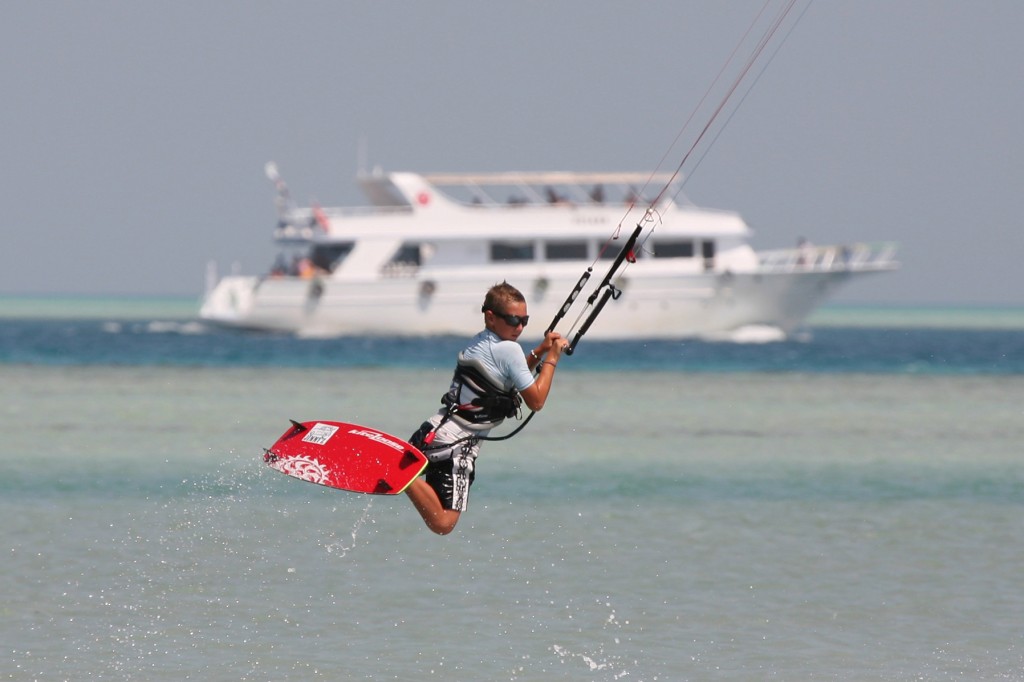Google Kitesurfing destinations or other such terms and in the top spots you will find Egypt, along with other exotic locations such as Brazil, the Caribbean and Indonesia. The big difference, and this is what makes this country so attractive, is that Egypt is just a few hours flying time from airports in Europe, Russia and the Middle East. It offers a choice of holiday options to suit all pockets along the coast of the Red Sea.
With many waist-deep warm blue water lagoons to learn and kite in, Egypt is a dream destination for kiters of all levels, from complete beginners to professional kitesurfers on training camps. The dramatic natural backdrops and the beautiful light in Egypt make it the location for commercial video and photo shoots. It is hard to find a more inspiring destination for a kitesurf vacation, even if it is just for a couple of days; it is world class and yet right on many people’s doorstep.
Kiters do not have to wear wetsuits from spring to late into the year. October and November are wonderful months for the sport, when the intense heat of summer has passed and the water is still warm enough to kite all day and end with socialising outdoors during the balmy evenings.
Many people return to Egypt time and time again to kite and with the presence of many kite stations online they can get all the necessary information to make an informed decision on where they will harness the wind next. While some leave it until the last minute to book their holiday, others plan months in advance and have lively emails with their chosen kite stations before they arrive.
Kiteboarding is a great way to meet new people and it is a fantastic sport that invites you to share experiences with others and make new friends. The fact that kitesurfers are overall a sociable breed has lead to countless forums on the internet, where experiences are shared. The word has spread on Egypt and its favourable kiteboarding conditions, which has lead to an exponential growth of the industry which was in its infancy just a few years ago. Kite magazines have featured Egypt countless times, in full features, images and the advertisements they present.
Not surprisingly, the number of repeat guests coming to Egypt to kitesurf is high and post revolution, in places like El Gouna, the kitesurfers were the first to return. They waited impatiently for the flights from their countries to resume or took multiple legs to return to Egypt.
The contrast of the intense blues of the ocean with the rich rusts and ochres of the sand and the vivid reds, browns and purples of the distant mountains are a visual feast no kiter soon forgets, even more so with ones’ senses heightened by carving through the blue lagoons powered only by the wind. Kitesurfing lends itself to reverie on the water and in the wind and be one with nature like very few other sports. Once a month, as the sun sets behind the mountains and full moon rises huge and red out of the sea, there is nowhere else to be but on the water for true kitesurfers.
The winged visitors passing through the Red Sea migration corridor and the diversity of sea birds along its coast are unsurpassed. To be able to ride alongside these exquisite creatures is humbling and a real privilege that I have not experienced in the same degree anywhere else. Added to these wonders of nature, for the very lucky few, even dolphin encounters are possible while kiting in the Red Sea.
With such great conditions, there are plenty of established schools to choose from. Make sure to choose one that operates to international standards of one of the two of the main teaching systems; IKO (International Kitesurf Organisation) and VDWS (Verband Deutscher Windsurfing und Wassersportschulen).
By learning methodically through an internationally recognised system, with a qualified instructor you will learn all the basics and become a safe kiteboarder. Then it comes down to getting the hours on the water to practice riding on the board with the option of taking extra instruction to learn new skills and hone existing ones.
Introductions to kitesurfing are often free, so before committing to a full course it is possible to get a taster for flying a trainer kite on land. You will find it is hard not to get hooked by the amazing feeling of controlling the power of the kite. When you watch the tricks and antics of the riders on the water, everyone has such an amazing time, no matter what their level or experience is.
A full kitesurf training course normally takes around nine hours, divided over three (windy) days, but the exact duration will be determined according to the school and the size of the group. The schedule will be set based on the tides and the wind forecasts as well, so be prepared to be flexible and allow a little more time to finish the course.
Most schools have teachers of varying nationalities and English and Arabic are widely spoken. Other languages such as German, Polish, French, Russian and Dutch are also often spoken but it depends on the school, so check before you start if you can take your course in the language of your choice.
Egypt is top of the list of destinations in VDWS, (Aegypten begins with A in German), which makes it the first choice for overseas destinations for many German speakers. With no less than 18 centres to choose from on the Red Sea it is no wonder so many visitors choose Egypt each year and they return time and time again. The standards are high and the dedicated schools are well spread along the coast, in addition there are smaller schools with certified instructors that teach to the same standards and certification.
IKO lists seven affiliated centres and in between there are many independent schools with qualified IKO instructors teaching according to their standards and give out proper certification on completion of the course.
So what to expect from a course? The skills learnt are similar via either route, as can be seen below:
VDWS
- Level 1: Safety basics, getting ready, start flying, take off, bodydrag
- Level 2: Bodydrag, relaunch
- Level 3: Waterstart, going downwind (minimum 50 metres)
- Theory: Basic theoretical knowledge, test
- Level 4: Going downwind, changing direction, keep position to wind, basic jibe
- Level 5: Going upwind
- Level 6: Basic jumps and carved jibes, or transition jumps
- Level 7: Rotation or kiteloop, grabs, one foot, board off or railey
IKO
Discovery – Kiteboarder Level 1 on land (2-4 hours)
- Level 1A: Site selection
- Level 1B: Basic piloting
- Level 1C: Control systems
- Level 1D: Power control
- Level 1E: Self landing
Intermediate – Kiteboarder Level 2 in the water (6-8 hours)
- Level 2F: Downwind drag
- Level 2G: Upwind drag
- Level 2H: Steady pull
- Level 2I:Waterstart
Independent – Kiteboarder Level 3
- Level 3J: Edging
- Level 3K: Upwind riding
- Level 3L: Turns
- Level 3M: Self launch
- Level 3N: Basic jump
After some essential paperwork, expect some theory and to learn about the equipment you will use. This does not take long normally and then it is time to get the harness on and start flying with a small foil trainer kite on land, to gain experience in kite control before moving on to the larger tube kites, (so called because they have a framework of air filled bladders).
Once you get in the water you will be wearing more equipment, such as a buoyancy aid as well as the harness and maybe booties and a wetsuit. Kite piloting continues in the water and it is a really exciting feeling of being pulled through the water for the first time.
Initially you will just be standing and steering, lowering and raising the kite, as if you are launching and landing, before you move on to controlled body dragging. Firstly straight down wind and then cross wind. Steering the kite with one hand and using the other arm as a rudder to steer your body, using the power of the kite against the resistance of the water. It is exhilarating and does not require Herculean strength as the kite power is delivered through the harness, and the kite is steered with the bar in both hands.
In addition to this you will learn and practice with the quick release and safety system and how to pack down your kite completely on the water.
Once you have kite control down pat, the instructor will introduce you to the board. First, with some water start simulation on land and then into the water. Be warned, this comes more naturally to some than to others, just controlling the kite while putting the board on can take a bit of getting used to.
You will practice steering the kite into the power in order to come up on the board and ride, be prepared to take many dips in the water! The course concludes with the certification but this is only the beginning. It takes practice to improve your riding skills and as well as getting time on the water its possible, and a good idea, to take more instruction and get certified to a higher level. This can be anything from simply improving stance, your body position on the board, to riding upwind to making turns. Next step would be riding toeside to making simple jumps. And it does not end there; you will see people jumping, doing high jumps, rotations and handle passes made in the blink of an eye. The more you ride the more it becomes clear where your interests lie.
It is important to carry your certification with you if you already have one because the better stations will ask to see it before allowing you to kite or rent equipment. Forget your certification and you may be required to pay for and take a check out session with an instructor before being allowed to rent or even to kite with your own equipment. Annoying as this may be, it is for the safety of everyone on the water.
Equipment rental is widely available for experienced riders and again it is sensible to check what equipment is available for hire, the cost and if there is an option for insurance. For riders with their own equipment storage and rescue packages are normally available. It is noteworthy that kiting on the Red Sea is usually a paid activity on designated kite beaches with common sense rules and a beach service with experienced beach boys to help launch and land. Kite stations normally operate a safety (rescue) boat for everyone during working hours.
Kitesurfing from the beach is the most popular, but other options include organised downwind trips between kite spots or complete Kite Safaris that range from an overnight trip to a week on a boat, cruising between the Red Sea kiting spots and deserted beaches that are accessible only by boat.
As the resorts vary, the other activities and nightlife on offer will vary too, for the no wind or rest days, or for non-kiting family members or friends. To combine the best of both worlds you can arrange for two centre breaks, combining the liveliness of a resort such as El Gouna with the isolation of Hamata. The possibilities are endless and limited only by your imagination and budget.
Most people ride on twin tip boards but directional boards are becoming more popular and with kitesurfing now an Olympic sailing class for Rio 2016, more and more people are learning to ride raceboards. Egypt has many talented national riders already so the move to raceboards was inevitable and with Egyptian athletes have year round riding on their doorstep to train, they could become a force to be reckoned with.
Freestyle is by far the most popular discipline and likely to remain so for most riders and it is the best style to perform incredibly complex tricks. Shortly before going to press the PKRA (Professional Kiteboard Riders Association) wrote, “the PKRA is thrilled to announce one of the most exciting tour stops for the 2013 season, in El Gouna, Egypt. Located on the Red Sea and famed for its resort feel, El Gouna will host the PKRA in true Egyptian style.”
This will be an incredible opportunity to witness not only the world’s best freestylers competing here in Egypt but also that Egypts’ best will be able to compete in their home country. It is possible to train with Egypts’ best riders here on the Red Sea, like the champions in their own categories Emad and Gogo at Surfvibes in the Palma Resort north of Hurghada, or Nemo at Red Sea Zone and Momo at Kitepower, both in El Gouna. In addition there are many visiting champions from overseas who come to the area to train throughout the year.
In the Sinai the main centres are located in Ras Sudr, with others at Dahab and a centre in Sharm el Sheikh, based in the Hotel Regency. Ras Sudr, 150 km or so by car from Cairo, has massive beaches but is more limited in other activities. Sharm and Dahab have kite centres, although not in the main towns.
On the mainland there is a centre at Za’afarana in the north, however there are limited tourist facilities. El Gouna has kite stations in two of its hotels and a whole kite beach with three kitestations to the North of the town. As a purpose built gated community and resort town, it has all sorts of accommodation and restaurants to choose from and numerous other activities on offer.
Moving down the coast towards Hurghada there are more kite schools close to the resort hotels and apartment complexes. The kite schools in El Gouna and at Palma Resort have a good relationship so organise escorted downwind trips from El Gouna accompanied by boat and normally finishing with a beach BBQ before transport back to El Gouna.
Hurghada has mostly hotel based schools, with one of the largest being at Magawish. Further south still are stations in Soma Bay and Safaga. Arguably it is more windy there, but there are fewer other activities on offer compared to the towns of El Gouna and Hurghada. Much further south there are kitestations at Marsa Alam and beyond to the kite camps and huge deserted lagoons in Hamata.
Wherever you decide to look at, learn or practice; kitesurfing is supposed to be fun! Do not be put off by the athletic advanced freestylers. Go at your own pace with an instructor you can relate to. Having a general level of fitness and feel comfortable in the water is all that is needed.
What makes kiteboarding so remarkable is that the sense of camaraderie crosses sex and age barriers, cultures and kiteboarding levels, from complete beginner to champion.







